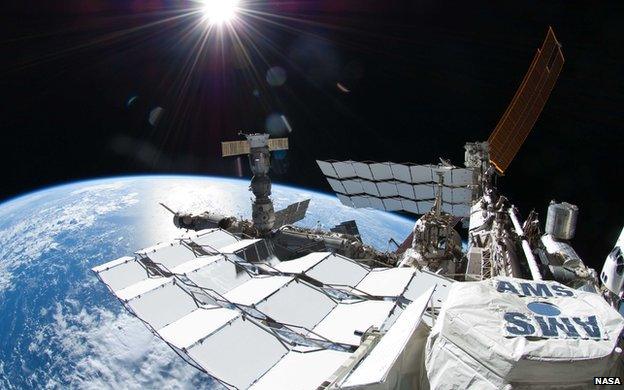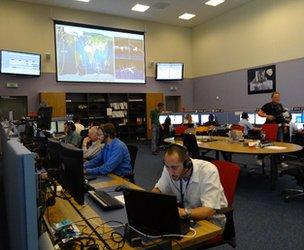Alpha Magnetic Spectrometer claims huge cosmic ray haul
- Published

The experiment, seen here installed on the space station, cost some $2bn
The largest-ever experiment in space has reported the collection of some 18 billion "cosmic ray" events that may help unravel the Universe's mysteries.
The data haul is far greater than the total number of cosmic rays recorded in a full century of looking to date.
Run from a centre at Cern, the Alpha Magnetic Spectrometer (AMS) aims to spot dark matter and exotic antimatter.
The astronauts who installed it on the space station in 2011 are in Geneva to see an update on how it is performing.
Mission commander Mark Kelly told reporters that AMS was "the pinnacle of the science that the ISS will do".
The huge number of events seen by the experiment includes some of the highest-energy particles from the cosmos that we have ever seen.
Kelly's flight - the STS-134 mission - was the last for the shuttle Endeavour before it was retired from the Nasa fleet.
The crew visited the Payload and Operations Control Centre at Cern on Wednesday, where a shift of six scientists is watching what is whizzing through the AMS 24 hours a day.
Seven-tonne giant
AMS deputy spokesman Roberto Battiston told BBC News that seeing the astronauts back in town was "a great joy".
"We are really thankful of these astronauts because we should never forget they put their lives at stake to do something that for us is pure fun - that is our interest, our curiosity," he said.

Mark Kelly (C) said AMS was the most significant experiment on the space station
"They have high expectations that the AMS will find something interesting, because they put a lot of effort into it. They feel part of the family."
At the heart of the seven-tonne, $2bn machine is a giant, specially designed magnet which bends the paths of extraordinarily high-energy charged particles called cosmic rays onto a series of detectors, giving hints of what the particles are.
A series of ever-larger particle accelerators built here on Earth aim to drive particles to ever-higher energies, smashing them into one another to simulate the same processes that create them elsewhere in the cosmos.
But no Earth-bound experiment can match nature's power as a particle accelerator - and Earth's atmosphere absorbs incoming cosmic rays - so the AMS will catch some of these high-energy particles "from the source", as a kind of complement to the likes of the Large Hadron Collider.
In scientific terms, the stakes could not be higher. The AMS should be able to spot the results of collisions of the mysterious dark matter that makes up most of the mass of our Universe, catch completely new forms of matter that include the aptly named "strange" quark, or resolve why the Universe we see is made mostly of matter rather than antimatter.
"It took more than 35 missions to build the International Space Station - very complicated space shuttle flights - to construct this incredible laboratory in space," said Captain Kelly.
"When we installed AMS, that was the last piece of the ISS, then the space station was complete. This is really the pinnacle of the science that ISS will do, in my opinion the most significant experiment we have on board."
In its 14 months of operation, the AMS has logged some 18 billion cosmic rays - more than collected in a century of looking before now.
But the AMS is a one-of-a-kind machine, so it has taken some time just to understand what it is seeing hundreds of times per second - and the team has only analysed a few percent of the data.
Nobel laureate Sam Ting of the Massachusetts Institute of Technology (MIT) has led the project since its inception some 17 years ago, through a number of setbacks and budget concerns that nearly saw the project shelved altogether - until an act of the US Congress and an unscheduled shuttle mission put it in space.
The team has already noted an excess of extremely high-energy positrons - the antimatter equivalent of electrons - and atomic nuclei at 9 teraelectronvolts (TeV) - higher even than the LHC can produce.
But Prof Ting is interested most of all in careful, methodical work, and is in no hurry to formally announce any findings.
"I have told my collaborators that in the next 40-50 years it is very unlikely people will be so foolish as to repeat this experiment, given the difficulty I ran into," Prof Ting told BBC News.
"Therefore it's extremely important when we publish a result, we publish it correctly, because otherwise you'll certainly mislead physics and there's no way to check us."
Looking for answers
Mission specialist on STS-134 Greg Chamitoff told BBC News that it was "great to be able to celebrate together" with the AMS team.
"If they discover an antimatter particle - even one - that'll be phenomenal, because they'll also know which direction it came from and they might be able to say 'that galaxy over there is an antimatter galaxy'," he said.
"What we learn from what it discovers could really transform our understanding of what's in the Universe."
The astronauts were accompanied by their wives, including STS-134 mission commander Mark Kelly's wife, Arizona congresswoman Gabrielle Giffords. The trip to Cern is her first international journey since recovering from a gun attack in her home state just a few months before the mission.

Cern in Geneva hosts the control room for the AMS experiment
Cern's director of research Sergio Bertolucci welcomed the visitors, saying "it is a clear sign that we'll not find our answers in only one place".
"The fact that AMS is addressing some of the same questions (as the LHC) is in my opinion a nice way in which we see that in this field we cannot get too specialised because probably the answer we're looking for... needs more, different inputs," he told BBC News.
"After all, we're trying to explain this small thing: why the Universe is like it is."
Prof Ting stubbornly refuses to be drawn on what he expects, or even hopes, to find as the team catches up with its glut of data.
Instead he imagines that perhaps we cannot conceive of what is to come.
"Look at particle physics in the last half century," he said.
"In the 60s, the largest accelerators were at Cern and Brookhaven, to study nuclear forces. At Cern, they discovered neutral currents; at Brookhaven they found two kinds of neutrinos, CP violation and the J particle. All three were given Nobel prizes.
"At Fermilab, the original purpose was to study neutrino physics, what was discovered was the fifth and sixth quarks.
"When you build something new, you ask the best expert what could be discovered, but what you discover with a precision instrument normally has nothing to do with the original purpose."
- Published27 April 2011
- Published19 May 2011
- Published17 May 2011